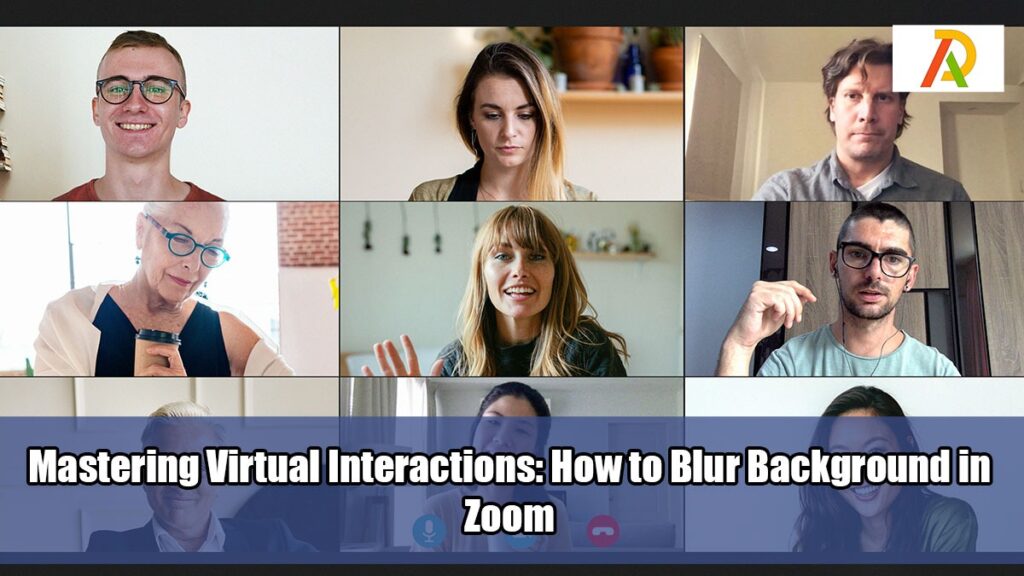Mastering Virtual Interactions: How to Blur Background in Zoom

As the digital age marches on, video conferencing platforms have become vital personal and professional communication tools. Among these platforms, Zoom stands out for its myriad of user-friendly features to enhance the online communication experience. One such feature that has gained widespread popularity is the ability to blur the background during a video call. This powerful feature not only aids in maintaining privacy but also ensures that the attention remains on the speaker rather than the surroundings. In this article, we will delve deep into understanding how to blur the background in Zoom, elevating the professionalism and focus of virtual meetings, classes, or social gatherings.
In an age of working from home, attending virtual classes, and participating in digital social events, ensuring our online communication is as efficient and undistracted as possible is vital. Zoom’s blur background feature plays an instrumental role in achieving this goal.
The Blurring background during a video call serves two main purposes: enhancing focus and preserving privacy. By blurring out potentially distracting elements in your environment, it ensures that the attention of other participants remains firmly on you, thereby enhancing communication effectiveness. At the same time, it adds a layer of privacy, concealing any personal or sensitive information that may be visible in your surroundings.
Understanding how to blur the background in Zoom is not a valuable technical skill but an essential tool in today’s digital communication toolkit.
Understanding Zoom’s Background Features
Zoom provides its users with several ways to manipulate their virtual environment during a video call, giving them control over how they appear in their digital interactions. There are primarily two options: using a virtual background or blurring the existing one.
Virtual Background
The Zoom virtual background feature allows users to completely change their backdrop during a Zoom meeting. Users can select an image or a video from Zoom’s pre-loaded options or upload their own. This feature completely masks the real environment and superimposes the chosen virtual background. This can be particularly useful for users who want to maintain a high level of privacy or add a fun element to their video calls.
However, using this feature effectively may require a green screen or a plain, uniformly colored backdrop for the best results. The absence of such a background could result in parts of the user’s body or environment becoming transparent or taking on the color of the virtual background.
Blur Background
The ‘Blur’ feature on Zoom operates slightly differently. Instead of replacing the actual background with a new image or video, the blur feature gives the existing background a soft, out-of-focus effect. This ensures that while your real environment is still visible, all details are obscured, creating a distraction-free setting that allows other participants to focus on you and not your background.
The blurring feature doesn’t require a specific backdrop. It can create a professional appearance, irrespective of what your real surrounding skin it is a convenient option for users who may need a suitable backdrop for a virtual background or those who prefer not to replace their environment completely.
While both features help users control their virtual appearance, they serve different purposes. The choice between using a virtual background or the blur feature on Zoom depends on a user’s specific needs: privacy, professionalism, or just a touch of fun.
A Step-by-Step Guide on How to Blur Background in Zoom
Before we proceed, it is important to note that the blur background feature is not unavailable on all devices. It requires Zoom version 5.5.0 (13142.0206) or higher and is supported on Windows, macOS, and iOS devices. It is not available on Android devices or Zoom Rooms as of now. Blurring your background in Zoom is a simple process, allowing you to bring professionalism and focus to your virtual interactions.
1. Start a New Meeting: Open the Zoom application on your computer. Click on ‘New Meeting’ to start a new video call.
2. Access Background Settings: Once the meeting starts and your video feed is active, find the video icon in the screen’s bottom left corner and click on the upward arrow (^) next to it. From the menu that appears, select ‘Choose Virtual Background.’
3. Select the Blur Option: A new window will open, presenting a selection of pre-existing backgrounds. Next to these, you’ll find the ‘Blur’ option, usually represented by a photo with a blurred background effect.
4. Apply the Blur Effect: Click the ‘Blur’ option. Your video feed will instantly update to show your current background blurred out. Close the settings window, and you’re all set! Your Zoom background is blurred, and you’re ready to proceed with your meeting.
Troubleshooting Tips When Blurring Background in Zoom
While blurring your background in Zoom is fairly straightforward, you might encounter some challenges. However, understanding the system requirements, proper lighting arrangements, and suitable backdrop can help you troubleshoot these issues effectively.
System Requirements
Zoom’s background blur feature is quite advanced and requires a relatively recent computer or mobile device to function properly. The feature employs complex algorithms and real-time image processing, which can be taxing on older hardware or outdated software.
If you can’t find the blur option in your settings, your device might not meet the system requirements for this feature. Updating your device’s operating system or upgrading the Zoom application to the latest version can often resolve this issue. It’s always a good practice to keep your applications updated for the best user experience and to enjoy the latest features and security updates.
Proper Lighting
Like any video capturing or processing task, proper lighting is key to effectively blurring your background in Zoom. Good lighting helps your camera capture clear images, and it was Zoom’s algorithms to better distinguish between you and your background.
Ensure that you are well-lit and that the main light source is in front of you, not behind. Backlighting can create a silhouette effect, making it difficult for the software to identify and separate you from your background. On the other hand, a well-lit subject against a less-lit background aids in accurately applying the blur effect.
Suitable Backdrop
Even though Zoom’s blur feature works with any background, a plain backdrop can yield better results. The blur effect work identifies the subject (you) and the background and then applies blur to everything except the subject.
A plain, uncluttered background, such as a white wall, can make it easier for the software to distinguish between you and your background. This results in a more accurate and visually pleasing blur effect. Conversely, a busy or moving background might need to be clarified for the software, leading to inconsistent blurring.
In conclusion, while blurring the background in Zoom is generally simple, understanding these tips can help you troubleshoot any potential issues and get the most out of this feature. Ensuring the system is up-to-date, setting up proper lighting, and choosing an appropriate backdrop enhance the blurring effect and make your virtual interactions more professional and distraction-free.
Enhancing Your Virtual Presence: Why Blurring Your Zoom Background Matters
In an increasingly digital world, understanding how to blur the background in Zoom is more than just a handy tech skill—it’s a significant asset in shaping your virtual persona. Whether engaging in a work meeting, attending a virtual class, or catching up with friends, knowing how to manipulate your online environment can significantly enhance your communication and overall online experience.
Adding Professionalism to Virtual Interactions
Blurring your Zoom background is a quick and effective way to lend an air of professionalism to your online meetings. Instead of allowing potential distractions or clutter in your background to divert attention away from your key messages, the blur feature helps ensure the focus remains on you.
By creating a clean, uncluttered visual space, you subtly emphasize your role as the central point of interest in the call. This can be particularly helpful during work presentations, job interviews, or formal online events where the first impression matters, and any distractions can dilute the impact of your presence or presentation.
Preserving Privacy in Digital Spaces
In addition to enhancing your professional image, learning how to blur your background in Zoom also adds a crucial layer of privacy to your digital interactions. Maintaining boundaries has never been more important, with more of our personal and professional lives merging into digital spaces.
Using the blur feature, you can effectively hide personal items or private spaces that might be visible in your background. This can be particularly useful if you’re sharing living spaces with others or if you have sensitive information that needs to be kept out of view.
Enhancing Communication and Engagement
Ultimately, the ability to blur your background in Zoom enhances engagement in your interactions. With potential distractions obscured and the focus kept on you, your audience is more likely to engage with your content. This leads to more productive discussions, effective presentations, and fulfilling social interactions.
Understanding how to blur the background in Zoom is essential for anyone seeking to maximize their virtual interactions. It’s more than just a tech trick—it’s a tool that helps you control your virtual environment, maintain your privacy, and enhance your professional image. So the next time you log on to Zoom, don’t hesitate to try out the blur feature. You might be surprised to see the difference it can make in your online experience.


